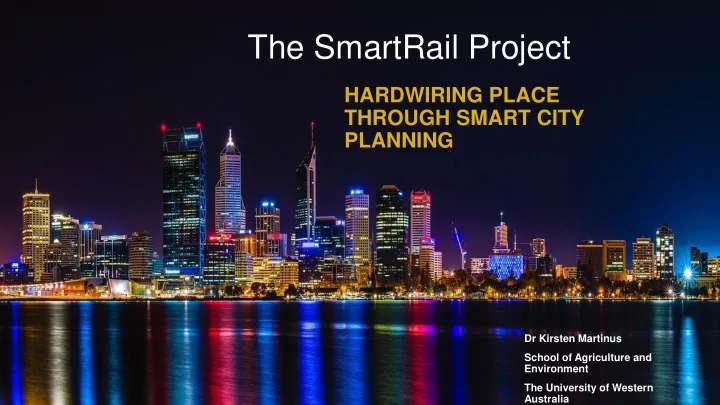

The SmartRail Project HARDWIRING PLACE THROUGH SMART CITY PLANNING Dr Kirsten Martinus School of Agriculture and Environment The University of Western Australia
City of Wanneroo sought to maximise the benefits of heavy rail investment to catalyse employment growth and transit-oriented activity centres. This sparked a project with PATREC to enhance planning capability through a fit-for- purpose planning tools and a integrated open data platform. The project won $1M in Federal Government SmartCities SmartSuburbs Program that challenged current modes of rewiring place https://railsmartwa.net.au/
https://railsmart.patrec.org/
OVER 60 YEARS OF PLANNING …
... HAS DECENTRALISED PLANNING WORKED? … biggest issue is access to amenities and opportunities, … and structural disadvantage … .
RESIDENTIAL WEALTH
THE CHALLENGE: STRUCTURAL DISADVANTAGE .... ECONOMIC ACTIVITY
Perth 87% Suburban
JOBS – TO – WORKERS
PLANNING MEASURES TO ADDRESS THE IMBALANCE: CURRENT HARDWIRING STRATEGY
SMARTRAIL: RETHINKING HOW WE HARDWIRE PLACES
DEFINED JOBS: POPULATION-DRIVEN JOBS ... Job growth due to local demand Even with limited intervention, job growth will naturally follow housing development as services are needed for its growing local population.
DEFINED JOBS: STRATEGIC-DRIVEN JOBS ... Job growth due to national or global demand ...respond to a more complex set of location and business dynamics. They are not distributed evenly across a city, and increasing them means focusing on fewer but higher quality job growth and multipliers.
A NEW APPROACH... • Planning targets should increase both population-driven and strategic jobs , but current targets do not distinguish between them. • This creates greater spatial inequality as strategic jobs are attracted to places with more amenities and infrastructure, such as the CBD and surrounds, air or sea ports, and specialised knowledge districts. • Outer metropolitan locations will have population-drive jobs, but struggle to attract strategic jobs unless there is a specific strategy to do so. • More nuanced measures of employment growth are needed to differentiate between these employment types.
HOW THIS WORKS ... AT THE JOONDALUP NODE
MODELLING ECONOMIC DRIVERS: LOCATION QUOTIENTS
CHANGE IN JOBS AT THE LGA LEVEL: AUSTRALIAN I/O TABLES
CONCLUDING COMMENTS • Current employment targets (SS/SC/JHB) and predictors have not worked, need reframing of how we hardwire places. • Rethinking jobs (strategic and population driven) and how these are understood comparatively at the metro level. • Reduction of travel is a limiting objective (as SS/SC/JHB does) - overlooks the spatial disadvantages in access to job opportunities. Better to focus on the creation of quality jobs (rather than quantity). • Can’t continue with business -as-usual model. Need to challenge how da data ta is used to construct (and hardwire) real spaces.
Recommend
More recommend